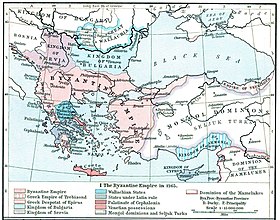Morea
This articleneeds additional citations forverification.(October 2010) |

Morea(Greek:ΜορέαςorΜωριάς) was the name of thePeloponnesepeninsula in southernGreeceduring theMiddle Agesand theearly modern period.The name was used for theByzantineprovince known as theDespotate of the Morea,by theOttoman Empirefor theMorea Eyalet,and later by theRepublic of Venicefor the short-livedKingdom of the Morea.
Etymology
[edit]There is some uncertainty over the origin of the medieval name "Morea", which is first recorded in the 10th century in theByzantinechronicles.
Traditionally, scholars thought the name to have originated from the wordmorea(μορέα), meaningmorusormulberry,[1]a tree which, though known in the region from the ancient times, gained value after the 6th century, when mulberry-eatingsilkwormswere smuggled from China to Byzantium.
The British ByzantinistSteven Runcimansuggested that the name comes "from the likeness of its shape to that of a mulberry leaf".[2]
History
[edit]
After the conquest of Constantinople by the forces of theFourth Crusade(1204), two groups ofFranksundertook the occupation of the Morea. They created thePrincipality of Achaea,a largely Greek-inhabited statelet ruled by a Latin (Western) autocrat. In referring to the Peloponnese, they followed local practice and used the name "Morea".
The most important prince in the Morea wasGuillaume II de Villehardouin(1246–1278), who fortifiedMistra(Mystras) near the site ofSpartain 1249. After losing theBattle of Pelagonia(1259) against theByzantine EmperorMichael VIII Palaeologus,Guillaume was forced to ransom himself by giving up most of the eastern part of Morea and his newly built strongholds. An initial Byzantine drive to reconquer the entire peninsula failed in the battles ofPrinitzaandMakryplagi,and the Byzantines and Franks settled to an uneasy coexistence.
In the mid-14th century, the later Byzantine EmperorJohn VI Kantakouzenosreorganized Morea into theDespotate of the Morea.Sons of the emperor with the rank ofdespoteswere usually sent to rule the province as anappanage.By 1430, the Byzantines eventually recovered the remainder of the Frankish part of the Morea, but in 1460 the peninsula was almost completely overrun and conquered by theOttoman Empire.In these conquests, the coastal and port cities remained in the hands of the Venetians such asMonemvasia,Lepanto,Modon,Koron,but these places were captured during the reigns ofBayezid IIandSüleyman I.[3]In July 1461, the last holdout,Salmeniko Castle,was taken.[4][5][6][7][8][9]
The peninsula was captured for theRepublic of VenicebyFrancesco Morosiniduring theMorean Warof 1684–99. Venetian rule proved unpopular, and the Ottomans recaptured the Morea in a lightning campaign in 1714. Under renewed Ottoman rule, centered atTripolitsa,the region enjoyed relative prosperity. The latter 18th century was marked by renewed dissatisfaction. Armed bands of theklephtsemerged, undeterred by the brutal repression of theOrlov revolt.They wagedguerrilla waragainst the Turks, aided both by the decay of Ottoman power and the emergence of Greek national consciousness. Ultimately, the Morea and its inhabitants provided the cradle and backbone of theGreek Revolution.
Chronicle of the Morea
[edit]The anonymous 14th centuryChronicle of the Morearelates events of theFranks' establishment offeudalismin mainland Greece following the Fourth Crusade. Despite its unreliability about historical events, theChronicleis famous for its lively portrayal of life in the feudal community. The language in Greek versions is notable as it reflects the rapid transition from Medieval to Modern Greek. The original language of the Chronicle is disputed, but recent scholarship prefers the Greek version in MSHavniensis 57(14th–15th century, inCopenhagen). Other manuscripts include the MsParisinus graecus 2898(15th–16th century, at theBibliothèque nationale de France,Paris). The difference of about one century in the texts shows a considerable number of linguistic differences due to the rapid evolution of the Greek language.
See also
[edit]References
[edit]- ^"Henry George Liddell, Robert Scott, A Greek-English Lexicon, μορέα".Perseus.tufts.edu.Retrieved2013-12-03.
- ^Runciman,A Traveller's Alphabet,"Morea" )
- ^"Mora Yarımadası".Ansiklopedika.Archived fromthe originalon 24 June 2021.Retrieved24 June2021.
- ^"Monemvasia".Monemvasia. 1941-04-28. Archived fromthe originalon 2018-08-07.Retrieved2013-12-03.
- ^"Monemvasia Lakonia Peloponnese Greece. The travel and holidays guide to Monemvassia in Laconia. Sparti, Gytheio, Mystras, Mani, Elafonissos, Gytheio. Travel greece".Thegreektravel.com. 2013-08-26.Retrieved2013-12-03.
- ^"Welcome to our homepage".Katsoulakos.com.Retrieved2013-12-03.
- ^[1]ArchivedJanuary 10, 2012, at theWayback Machine
- ^"Genealogy - Geni - private profile - Genealogy".Geni.Retrieved2013-12-03.
- ^"The journal of Hellenic studies".Retrieved2013-12-03.
Bibliography
[edit]- Bon, Antoine (1969).La Morée franque. Recherches historiques, topographiques et archéologiques sur la principauté d'Achaïe(in French). Paris: De Boccard.
- Fine, John Van Antwerp (1994),The Late Medieval Balkans: A Critical Survey from the Late Twelfth Century to the Ottoman Conquest,University of Michigan Press,ISBN978-0-472-08260-5
- Crusaders as Conquerors: the Chronicle of Morea,translated from the Greek with notes and introduction by Harold E. Lurier, Columbia University, 1964.
- M.J. Jeffreys, "The Chronicle of Morea: Priority of the Greek Version."Byzantinische Zeitschrift68 (1975), 304-350.
- Teresa Shawcross,The Chronicle of Morea: Historiography in Crusader Greece(Oxford/New York: Oxford University Press, 2009) (Oxford Studies in Byzantium).
